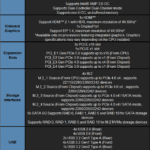
Introduction
MSI is one of the largest players in the DIY motherboard market and for good reason. It provides a wide range of motherboard options across most price points and market segments. The latter is where MSI has struggled a bit over the years. MSI has found most of its success in the consumer gaming segment. The motherboard we are looking at today is the MSI Z790-P WiFi Motherboard. Unlike most of the motherboards from MSI that we’ve looked at, the MSI Z790-P PRO WiFi is geared more towards a professional segment though it’s hardly a workstation motherboard.
At a price of around $209.99 at the time of this writing, it’s more towards the budget end of the spectrum price-wise. The feature set seems solid, but there are things missing to make it a true midrange offering. (More on that later.)
The MSI Z790-P WiFi is based on Intel’s Z790 Express chipset. Specifically, this is the DDR5 version with 4x DDR5 DIMM slots. The board supports PCI-Express 5.0, 4.0, USB 3.2 Gen 2, WiFi 6E, and all the other latest technologies.
Packaging and Contents
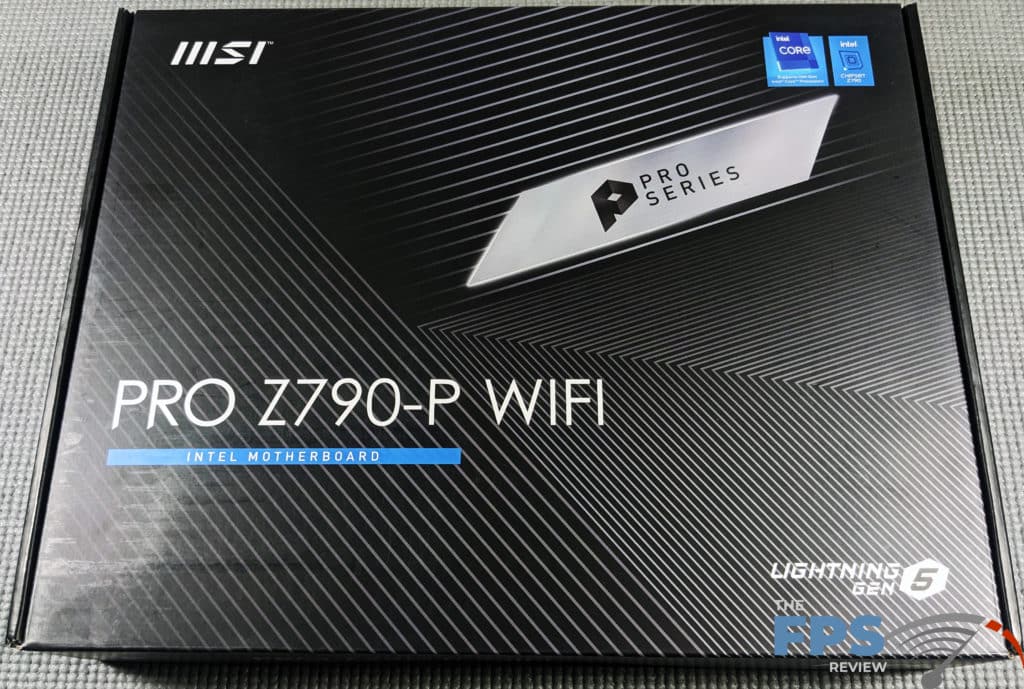
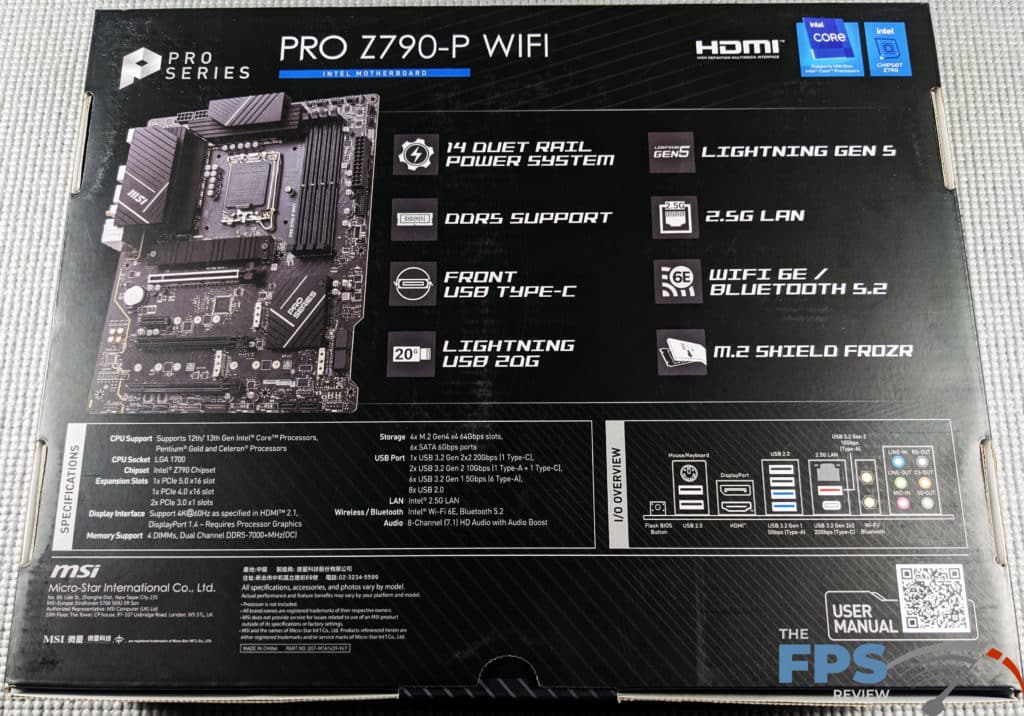
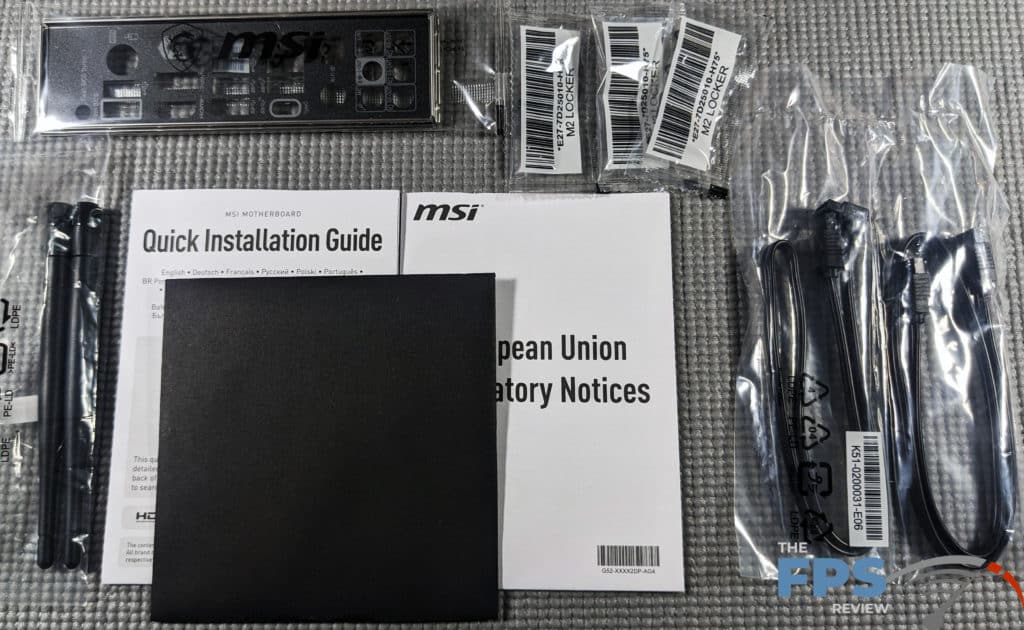
The packaging of the MSI Z790-P WiFi is rather basic but elegant in its simplicity. The motherboard is held in place by cardboard with some raised sections for the flat spots on the board. Inside the packaging, you’ll find the following accessories: Quick Installation Guide, Driver Disc, regulatory information sheet, WiFi antennas, SATA cables, 3x M.2 screw packs, and an I/O shield.
MSI Z790-P WiFi PCB & Features
The MSI Z790-P PRO WiFi offers a solid layout with very few things for me to complain about. The only two things I’d really knock it for are having vertical SATA ports and a somewhat unfortunate placement for the CMOS battery. I don’t imagine people putting a ton of SATA-based devices in a modern system, though if you need the utility the aesthetics may not be a serious concern.
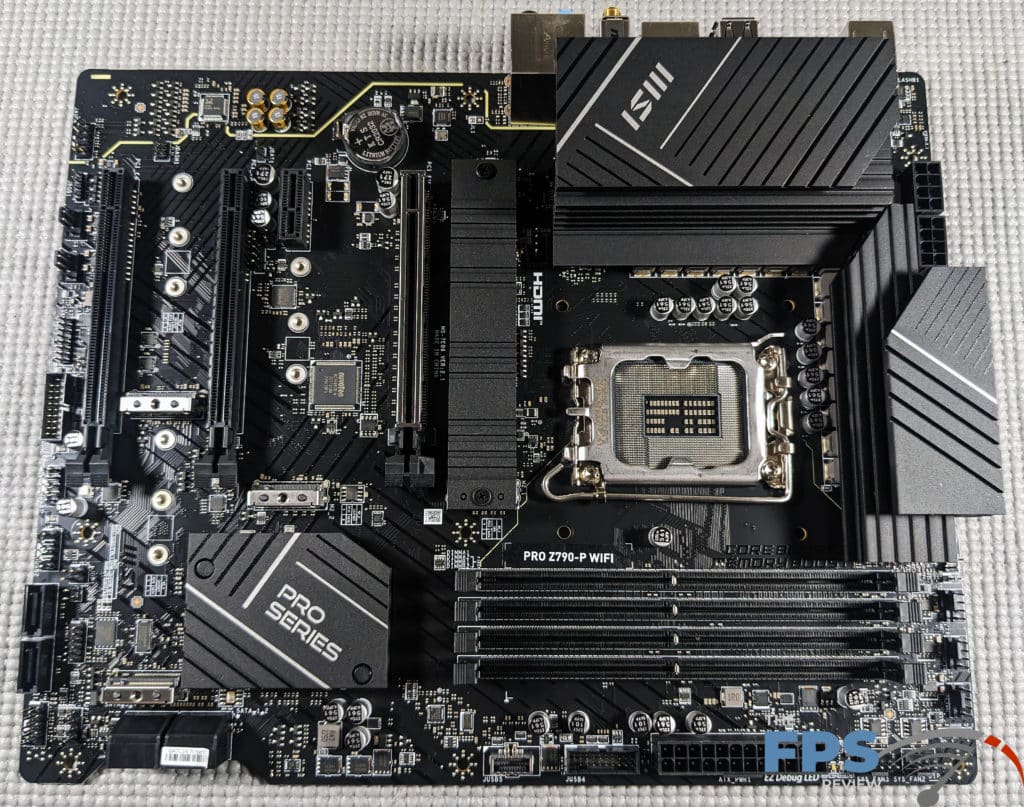
The Z790-P PRO WiFi is constructed using a 6-Layer 2oz copper PCB. MSI uses what it calls its DIGITAL power design. Moving on the PCB has 1x CPU fan header, 6x system fan headers, and 1x dedicated pump header. It also features a tuning controller connector for MSI’s dash, a TBT connector, 2x addressable RGB LED connectors, 1x RGB LED connectors, 1x TPM header, and the usual chassis intrusion headers, USB headers, and so on.
To be fair, despite the budget-friendly price point the Z790-P PRO WiFi is pretty well built compared to the budget boards I normally work with. The PCB feels sturdy, it’s nice and flat and the board’s heat sinks are well-made and well secured.
Power Delivery
MSI uses a 14+1+1 phase power design according to their website. It does show the phases are 55A. This seems a bit anemic given that a lot of mid-range boards are now running 60a plus power stages.


As is customary these days, there aren’t any phase doublers on the PCB. Meaning it most likely has two inductors per phase and it isn’t a true 14-phase design. Not only is this kind of marketing misleading but it’s incredibly common. Though I can’t actually say for sure as I haven’t pulled the heat sinks off this thing. That said, at this price point I seriously doubt it has 14 true phases. Out of the 14+1+ phases, 1 is an aux power phase and the other is a GT power phase. The motherboard also uses two heavy-duty 8-pin power connectors for CPU power input.
These VRMs are adequate for general use but you won’t be breaking any overclocking records on this thing. Given how these CPUs are binned these days I think that’s generally OK. It’s not necessarily the most efficient design, but it’s perfectly reasonable at this price point.
Memory
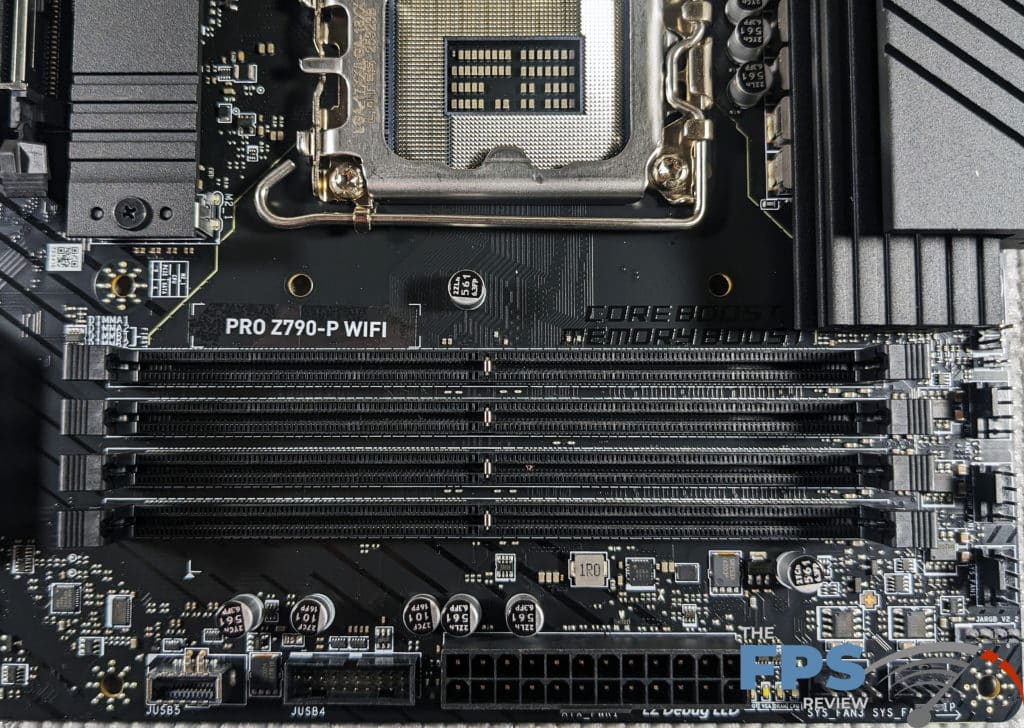
The Z790-P PRO WiFi has four 288-pin DDR5 slots supporting up to 192GB of RAM at speeds in excess of DDR5 7000MHz through overclocking. Of course, using all four slots and dual-ranked memory negatively impacts your performance. Even so, it’s capable of DDR5 5600MHz+ using four DIMMs which puts it well ahead of what was possible with DDR5 Z690 motherboards. The MSI Z790-P PRO WiFi also supports XMP 3.0 OC profiles.
In our testing, it also correctly identified and utilized EXPO as well. The memory slots are not color coded to denote proper dual-channel memory mode operation. However, the PCB is marked well enough to inform the user on how to configure the system properly.
MSI built the board using what it calls Advanced SMT or surface mount technology. MSI claims this reduces the defect rate of the solder joints. It also features its “memory boost” technology to deliver high-frequency DDR5 signals. Granted it’s hard to get past the standard marketing speak but MSI has held world records for memory overclocking in the past. We’ve seen some of their boards behave better than others with memory modules indicating MSI has expertise here. We’ll talk more about how this worked in practice later.
Expansion

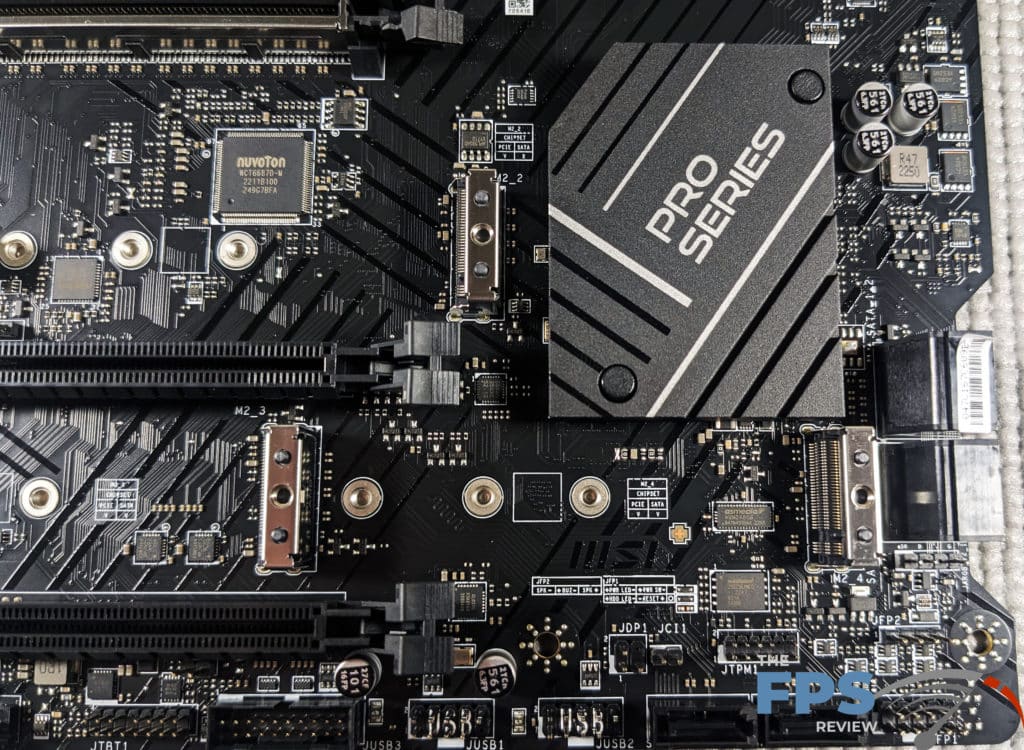
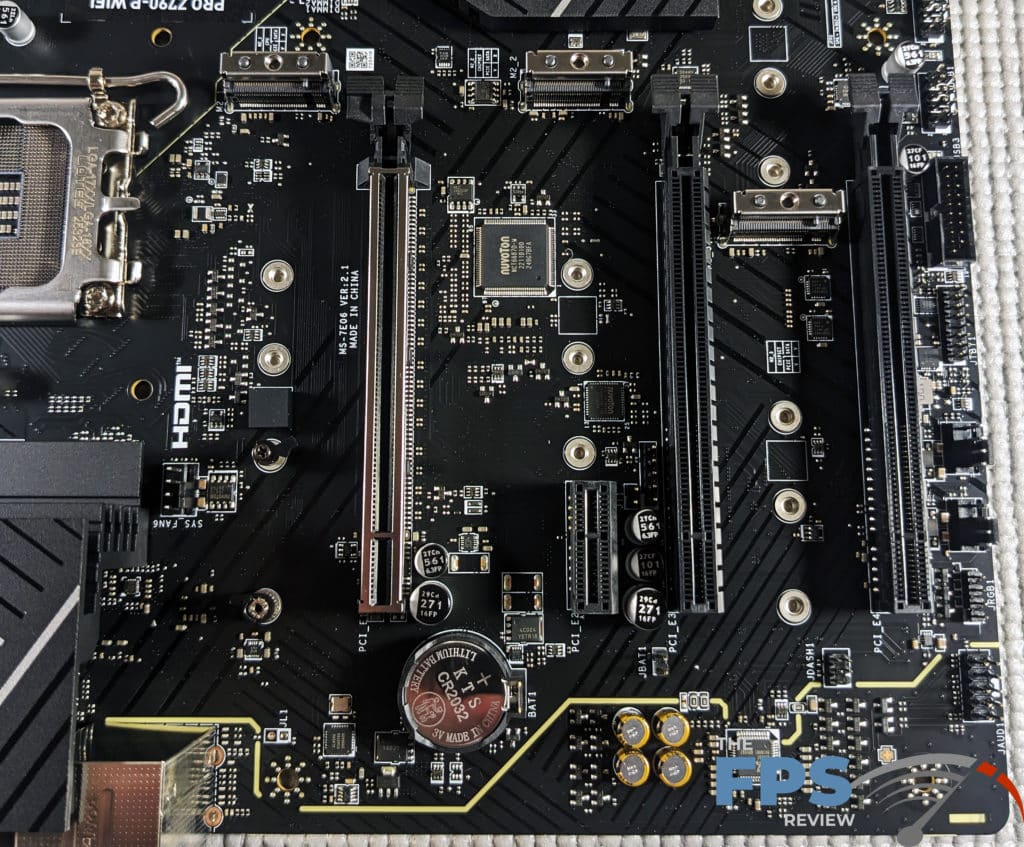
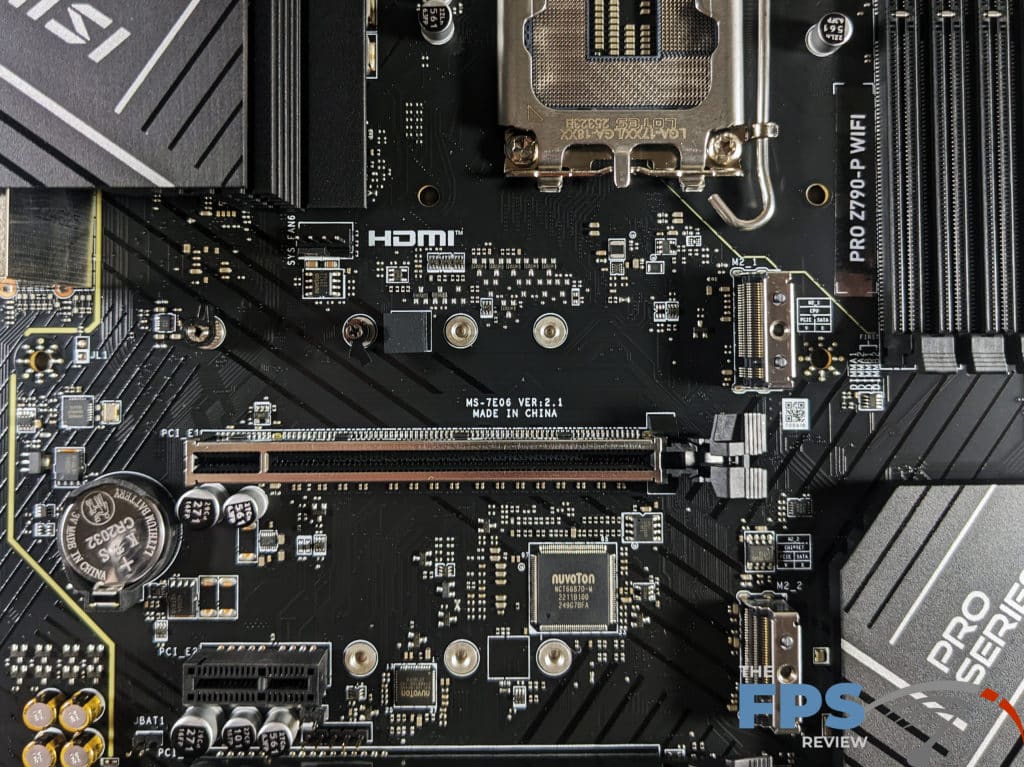
The expansion slot area is laid out extremely well. There is more than one way to do this with various pros and cons, but I think MSI took the right route here. The primary M.2 slot is above the primary PCI-Express x16 slot and features a heat sink. Although, the screws are sadly not captive. However, the M.2 posts have the levers to retain the drives so you don’t have to mess with super tiny screws.
The PCI-Express slots are well placed with plenty of space to utilize large graphics cards and still have slots accessible. Obviously, your mileage will vary based on the use of certain specific cards and devices but this layout should be fine for most people.
MSI uses what it calls “Steel Armor” to reinforce the slots. It also uses its surface mount technology for the expansion slots. Like the PCI-Express slots, the M.2 slots are well placed and the use of the retention levers is really nice. However, only M.2_1 offers a heat sink for better or for worse. M.2_1 is also the only slot that supports type 22110 devices. This slot also gets its PCIe lanes from the CPU rather than the chipset or PCH. The other three slots get their lanes from the chipset. Slots M.2_3 and M.2_4 support SATA-type devices as well but M.2_2 does not.
RAID 0, 1, RAID 5, and RAID 10 are all supported for both SATA and NVMe storage device types.
Network Hardware
The MSI Z790-P PRO WiFi offers both Intel’s i225v which is a wired 2.5Gbps controller, and Intel’s Wi-Fi 6. It supports the following standards and features: MU-MIMI TX/RX, 2.4GGHz, 5GHz, and 6GHz speeds up to 2.4Gbps are supported. It also supports Bluetooth 5.3, FIPS, and FISMA.
Unfortunately, the Intel wired connection gave me a considerable amount of trouble About every other time I’d power up the test system I’d have no connectivity no matter what I did. However, a simple reboot would restore connectivity and I’d have zero issues afterward until the next cold boot. Unfortunately, applying the latest BIOS didn’t seem to resolve this issue. As for the wireless, I had no trouble with it though my test network is outdated so I don’t exactly have the ability to truly leverage the wireless controller.
Audio Hardware
MSI reveals very little about its onboard audio implementation on its website. However, I have confirmed it’s a Realtek ALC897 7.1 Channel HD audio CODEC. To say this controller is long in the tooth is a bit of an understatement. This is a very old CODEC at this point and probably stretches back the better part of a decade. This is a common area to cut costs on budget motherboards so I can’t say this is surprising at all. Ordinarily, you would see a S/PDIF connector. However, you will not find that on the MSI Z790-P Pro.
MSI does list the board as using chemicon audio capacitors and PCB isolation for the audio subsystem. Since this dates back to around the Z170 Express chipset I’d hope so. It also does have a De-Pop circuit and claims “high quality” audio jacks. Near as I can tell, the six plastic-clad mini-stereo jacks are literally the same as they are on any low-end or mid-range motherboard on the market. At least they are color-coded to make things easy.
The audio solution isn’t fantastic. However, it’s reliable. It worked well while playing games or watching streaming content so I can’t complain too much other than to say, it’s an older implementation and it doesn’t break any new ground or innovate in any way. That being said, the use of the time-honored design also means that it just works.
Rear I/O Panel

Unfortunately, the rear I/O panel lacks a built-in I/O shield. However, that’s not terribly uncommon with more budget-oriented motherboards. There are a good amount of USB ports here for the price point. You have 4x USB 2.0 ports, 2x USB 3.2 Gen 1 Type-A ports, 1x USB 3.2 Gen 2 Type-A ports, and 1x USB 3.2 Gen 2×2 Type-C ports. You will also find dual-antenna jacks, 1x PS/2 keyboard or mouse port, 1x HDMI port, 1x DisplayPort, 1x 2.5GbE RJ-45 port, BIOS flash button, and six mini-stereo style jacks. There is minimal color coding here but there is enough to make things easy.



